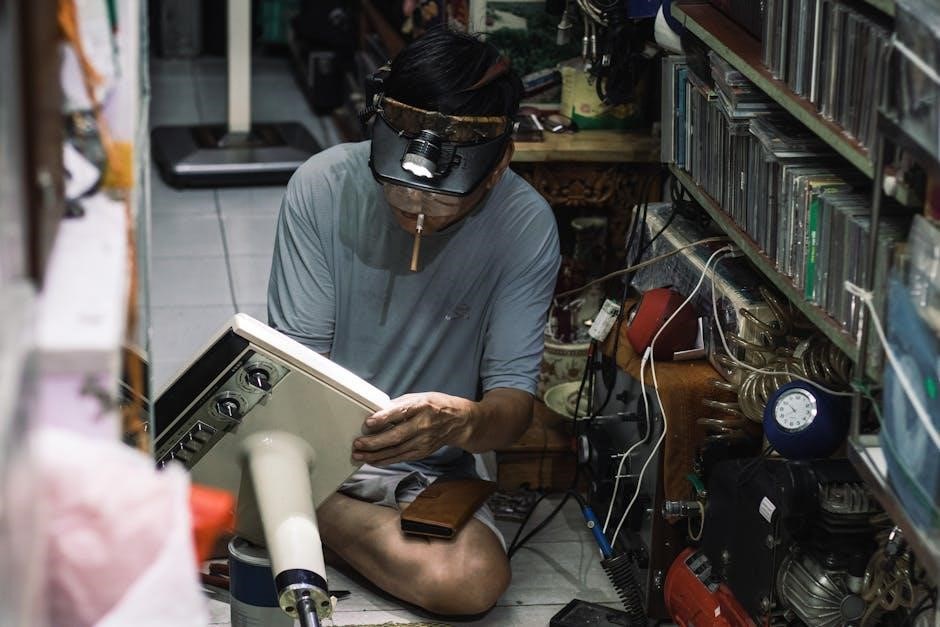The Singer 500a User Manual is your essential guide to understanding and utilizing your sewing machine effectively. It provides clear instructions, troubleshooting tips, and maintenance advice to ensure optimal performance and longevity of your device, helping you unlock its full potential with ease and confidence.
Overview of the Singer 500a Sewing Machine
The Singer 500a sewing machine is a versatile and durable model designed for both beginners and experienced sewists. Known for its ease of use, it offers a range of features that make sewing efficient and enjoyable. The machine is equipped with various stitch options, including straight and zigzag stitches, allowing for creativity in different projects. Its mechanical design ensures reliability, while the adjustable speed control provides precision for delicate fabrics. The Singer 500a also comes with essential accessories like presser feet and bobbins, making it a comprehensive tool for sewing enthusiasts. With its sturdy construction and user-friendly interface, this machine is a popular choice for crafting, repairs, and heavy-duty sewing tasks.
Importance of Reading the User Manual
Reading the Singer 500a User Manual is crucial for optimizing the performance and longevity of your sewing machine. The manual provides detailed instructions on how to operate the machine safely, troubleshoot common issues, and perform routine maintenance. It also offers valuable insights into the machine’s features, stitch options, and customization capabilities. By understanding the guidelines, you can avoid errors, extend the life of the machine, and ensure optimal results for your sewing projects. Additionally, the manual serves as a reference for resolving technical problems and accessing warranty information when needed. Whether you’re a novice or an experienced user, the Singer 500a User Manual is an indispensable resource to maximize your sewing experience. If misplaced, the manual can easily be downloaded online, ensuring you always have access to essential guidance.
Where to Download the Singer 500a User Manual
The Singer 500a User Manual can be conveniently downloaded from various online sources. Singer’s official website offers free PDF downloads for the manual, ensuring easy access for users. Additionally, third-party websites such as ManualsLib and Superior Sewing Machine & Supply provide downloadable versions of the manual. These platforms allow users to quickly search and retrieve the Singer 500a User Manual without hassle. If you’re unable to find it through these channels, Singer’s customer support can also assist in providing a digital copy. This ensures that you always have access to the essential guide, even if the physical manual is misplaced. Downloading the manual is a straightforward process, making it simple to refer to its instructions, troubleshooting tips, and maintenance advice whenever needed.

Key Features of the Singer 500a Sewing Machine
The Singer 500a Sewing Machine features a combination of mechanical and electronic controls, offering 50 stitch options, adjustable speed, and a variety of included accessories for versatile sewing tasks and projects.
Mechanical vs. Electronic Features
The Singer 500a sewing machine primarily features mechanical controls, offering a straightforward and reliable sewing experience. Its mechanical components, such as the motor and gear system, ensure durability and consistent performance. Unlike electronic models, the Singer 500a relies on manual adjustments for stitch length and tension, providing sewers with hands-on control. While it lacks advanced electronic features like automatic threading or stitch memory, its mechanical design makes it easy to maintain and repair. This simplicity appeals to users who prefer a no-frills, dependable machine. The Singer 500a strikes a balance between traditional mechanical operation and essential functionality, making it a practical choice for both beginners and experienced sewers seeking a hassle-free experience.
Stitch Options and Customization
The Singer 500a sewing machine offers a variety of stitch options to cater to different sewing needs. It includes essential stitches like straight, zigzag, and decorative patterns, providing versatility for both basic and creative projects. Users can manually adjust stitch length and width to customize their sewing experience. The machine also features a reverse stitch option to secure seams effectively. While it may not have advanced electronic stitch customization, its mechanical controls allow for precise adjustments, ensuring consistent results. This simplicity makes it user-friendly for beginners while still offering enough flexibility for experienced sewers to explore various techniques. The Singer 500a’s stitch options and customization capabilities make it a reliable choice for a wide range of sewing tasks.
Speed Control and Performance

The Singer 500a sewing machine is designed for efficient and consistent performance, offering smooth operation for a variety of sewing tasks. It features a mechanical speed control that allows users to adjust sewing speed according to their comfort and project requirements. This makes it suitable for both beginners and experienced sewers. The machine is known for its robust construction, enabling it to handle heavy-duty fabrics with ease. While it may not offer the fastest sewing speeds compared to modern electronic models, its steady and reliable performance ensures high-quality stitching. The Singer 500a’s mechanical design provides a straightforward sewing experience, making it a dependable choice for everyday use. Its performance is further enhanced by its ability to maintain consistent stitch quality, even when working with thick or layered materials.
Accessories Included with the Singer 500a
The Singer 500a sewing machine comes with a variety of essential accessories to enhance your sewing experience. These include multiple presser feet, such as the zigzag foot, zipper foot, and buttonhole foot, designed for specific sewing tasks. A set of needles is also provided, catering to different fabric types and projects. Additionally, the machine includes a bobbin and bobbin case, which are vital for proper thread setup. A seam ripper is included for easy correction of mistakes. These accessories ensure that you have everything you need to start sewing right away. The user manual further details how to use each accessory effectively, making it easier to explore various sewing techniques and projects with your Singer 500a.

Setting Up the Singer 500a Sewing Machine
Setting up the Singer 500a involves unpacking, inspecting, and preparing the machine for use; Follow the manual’s oiling, threading, and bobbin-winding instructions to ensure proper function and readiness for sewing projects.
Unpacking and Initial Inspection
When you receive your Singer 500a sewing machine, carefully unpack it from the box and inspect for any visible damage. Ensure all accessories, such as bobbins, needles, and presser feet, are included. Gently wipe the machine with a soft cloth to remove any packaging dust or debris. Check the power cord for damage and ensure it is securely connected. Before turning it on, verify that all components are in working order, such as the stitch selector and tension dials. If you notice any issues, contact the seller or manufacturer immediately. Proper inspection ensures a smooth setup process and helps you familiarize yourself with the machine’s features. This step is crucial for maintaining the longevity and performance of your Singer 500a sewing machine.
Oiling and Lubrication Instructions

Regular oiling is essential to maintain the smooth operation of your Singer 500a sewing machine. Locate the oiling points as indicated in the manual, typically near the bobbin area and the sewing head. Use high-quality sewing machine oil, applying a few drops to each specified point. Gently rotate the handwheel to distribute the oil evenly. Avoid over-lubrication, as excess oil can attract lint and dust, potentially causing mechanical issues. Clean any excess oil with a soft cloth to prevent residue buildup. Oiling should be done after every 10 hours of use or as needed. Proper lubrication ensures the machine runs quietly, reduces friction, and extends its lifespan. Always refer to the manual for specific oiling recommendations to keep your Singer 500a in optimal condition.
Threading the Machine: Step-by-Step Guide
Threading your Singer 500a sewing machine correctly is crucial for smooth operation. Begin by raising the presser foot and turning the handwheel to position the needle at its highest point. Locate the spool pin and guide the thread through the tension discs, ensuring it passes through the correct channels. Next, thread the take-up lever, moving downward toward the needle bar. Insert the thread through the needle from front to back, leaving a small tail. Gently pull the thread to seat it properly. Avoid crossing or looping the thread, as this can cause tension issues. Proper threading ensures even stitch formation and prevents machine malfunction. Always refer to the manual diagrams for precise guidance, as incorrect threading can lead to uneven stitches or machine damage. Correct threading is essential for optimal performance and professional results.
Winding and Installing the Bobbin
Winding and installing the bobbin is a straightforward process with the Singer 500a. Start by placing an empty bobbin on the bobbin winder. Ensure it is seated correctly for even winding. Thread the machine as instructed, guiding the thread through the tension discs and take-up lever. Once threaded, gently wind the bobbin by turning the handwheel or using the machine’s automatic winding feature. Stop winding when the bobbin is about 3/4 full to avoid overfilling. Cut the thread, leaving a small tail. To install, open the bobbin case, insert the wound bobbin, and pull the thread to set the tension. Close the case and ensure the bobbin is securely in place. Properly wound and installed bobbin ensures smooth stitching and prevents thread issues. Always refer to the manual for specific diagrams and guidance to achieve professional results.
Installing the Needle and Presser Foot
Installing the needle and presser foot on the Singer 500a is a simple process that ensures proper stitching and fabric handling. Start by turning off the machine and unplugging it for safety. To install the needle, locate the needle bar and loosen the needle clamp screw using the screwdriver provided. Carefully remove the old needle, taking note of its orientation. Insert the new needle, ensuring it aligns with the needle bar’s groove, and tighten the screw securely. For the presser foot, lift the foot using the presser foot lever and slide off the old foot. Attach the desired presser foot by aligning the pin and securing it with the lever. Make sure both the needle and presser foot are properly installed to avoid stitching issues. Always refer to the manual for specific diagrams and guidance to ensure accurate installation.

Operating the Singer 500a Sewing Machine

Operating the Singer 500a involves powering on, selecting stitches, adjusting speed, and monitoring progress. Ensure all parts are correctly installed and follow manual guidelines for smooth operation.
Basic Sewing Operations and Techniques
Mastering basic sewing operations on the Singer 500a begins with understanding its core functions. Start by familiarizing yourself with the machine’s controls, such as the stitch selector, speed control, and reverse stitch button. Practice straight stitching on scrap fabric to get a feel for the machine’s operation. Learn to properly align and guide fabric under the presser foot for even stitching. The Singer 500a allows for forward and reverse stitching, essential for securing seams. Experiment with different fabric types, adjusting tension as needed. For beginners, start with simple projects like hemming or straight-line sewing to build confidence. Always refer to the manual for guidance on optimizing stitch length and width for various materials.
Using Different Stitch Patterns and Lengths
The Singer 500a offers a variety of stitch patterns and adjustable lengths to cater to diverse sewing needs. From basic straight stitches to decorative zigzag patterns, each stitch type serves a specific purpose. For instance, the straight stitch is ideal for general sewing, while the zigzag stitch is perfect for elastic fabrics or decorative edges. Adjusting stitch length and width ensures proper fabric handling, whether you’re working with delicate materials or heavy-duty textiles. The manual provides detailed guidance on selecting the right stitch for your project and customizing settings for optimal results. Experimenting with these features allows you to explore creative possibilities and achieve professional-quality finishes in your sewing projects.
Free-Arm Sewing and Its Applications
Free-arm sewing on the Singer 500a allows for greater versatility and ease when working with cylindrical or hard-to-reach areas. By removing the auxiliary bed, you can sew sleeves, pant legs, and other curved fabrics with precision. This feature is particularly useful for tailor-made garments, home decor projects, and repairing delicate items. The free-arm design provides better control over the fabric, ensuring smooth stitching even in tight spaces. It also enables easy access for intricate embroidery or quilting details. With the Singer 500a, free-arm sewing simplifies tasks that would otherwise be challenging, making it an invaluable tool for both beginners and experienced sewists. This feature enhances creativity and efficiency, allowing you to tackle a wide range of sewing projects with confidence.
Reverse Stitching and Securing Seams
Reverse stitching on the Singer 500a is a simple yet essential feature for securing seams. By engaging the reverse stitch button, the machine sews backward, reinforcing the beginning and end of your stitches. This ensures that your seams are strong and prevent fraying, especially on delicate or heavyweight fabrics. The reverse stitch function is ideal for finishing garments, home decor, or repairs. It adds an extra layer of durability to your work, making it less likely for seams to come undone over time. To use this feature, press and hold the reverse stitch button before starting your seam. The machine will automatically sew in reverse for a few stitches, creating a secure anchor. This technique is a must for professional-looking results and long-lasting projects.

Maintenance and Troubleshooting
Regular cleaning, oiling, and lubrication are crucial for the Singer 500a’s smooth operation. The manual provides troubleshooting tips for common issues and maintenance routines to ensure longevity and performance.
Cleaning the Machine and Removing Lint
Cleaning the Singer 500a sewing machine and removing lint are crucial for maintaining its performance and longevity. Regularly dust and lint buildup can interfere with stitching and machine operation. Turn off and unplug the machine before cleaning. Use a soft brush or cloth to gently remove lint and debris from the bobbin area, feed dogs, and other visible components. Avoid using harsh chemicals or abrasive materials that could damage the finish. For stubborn lint, a small vacuum cleaner or compressed air can be used carefully. Clean after each project to prevent fibers from accumulating. Proper maintenance ensures smooth operation, consistent stitch quality, and extends the life of your sewing machine. Refer to the manual for specific cleaning instructions tailored to the Singer 500a model.
Troubleshooting Common Issues

Troubleshooting common issues with the Singer 500a sewing machine ensures optimal performance and minimizes downtime. If the machine does not turn on, check the power cord connection and ensure it is properly plugged in. For thread breakage, inspect the thread path for tangles or improper threading. Uneven stitches may result from incorrect tension settings or a dull needle, which should be replaced. Lint buildup can cause mechanical issues, so regular cleaning is essential. If the machine jams, gently remove the fabric and check for debris in the bobbin area. Refer to the user manual for detailed solutions and step-by-step guides. Addressing these issues promptly helps maintain the machine’s efficiency and extends its lifespan. Always follow the manual’s recommendations for resolving specific problems.
Replacing Parts and Accessories
Replacing parts and accessories for the Singer 500a sewing machine is straightforward when following the user manual’s guidance. Always use genuine Singer parts to ensure compatibility and maintain performance. Common replacements include needles, presser feet, and bobbin cases. To order, visit Singer’s official website or authorized dealers. Before replacing any part, consult the manual to identify the correct component and its installation steps. For complex parts like motors or gears, professional assistance may be necessary. Regularly check and replace worn-out accessories to prevent machine malfunction. Keep a list of spare parts handy for quick repairs. Proper replacement ensures the machine runs smoothly and extends its lifespan. Always follow the manual’s instructions for installation to avoid damage or voiding the warranty.

Additional Resources and Support
Explore Singer’s official website for comprehensive support, including downloadable manuals, warranty details, and customer service contacts. Join online forums for tips, troubleshooting, and community advice.
Warranty Information and Terms
The Singer 500a sewing machine comes with a comprehensive warranty designed to protect your investment. The warranty typically covers defects in materials and workmanship for a specified period, ensuring your machine performs optimally. Coverage often includes parts and labor for repairs, providing peace of mind for users. To validate the warranty, registration may be required upon purchase. Terms and conditions outline what is covered and what is excluded, such as damage from misuse or unauthorized repairs. For detailed information, visit Singer’s official website or contact their customer support team. Understanding the warranty terms helps you maintain your machine effectively and address any issues promptly.
Customer Support and Service Centers
Singer offers reliable customer support and a network of service centers to assist with any questions or issues related to your Singer 500a sewing machine. Whether you need troubleshooting guidance, maintenance tips, or repair services, Singer’s dedicated support team is available to help. You can contact them through their official website, phone, or email for prompt assistance. Additionally, authorized service centers located worldwide provide professional repair and maintenance services, ensuring your machine is serviced by experts. For more information on locating a service center near you or accessing support resources, visit Singer’s official website or refer to the user manual provided with your machine.
Online Communities and Forums for Singer 500a Users
Online communities and forums dedicated to Singer 500a users offer a wealth of knowledge, tips, and support. These platforms allow users to share experiences, ask questions, and learn from experts and fellow sewists. Many forums discuss troubleshooting, creative projects, and maintenance tips specific to the Singer 500a. They also provide a space to connect with others who own the same machine, fostering collaboration and innovation. Additionally, these communities often share links to downloadable resources, including manuals and guides, ensuring users have access to everything they need. By joining these forums, you can enhance your sewing skills and make the most of your Singer 500a sewing machine.
